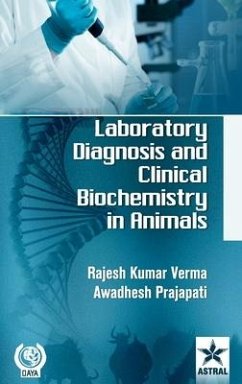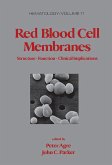Helen M Free
Urinalysis in Clinical Laboratory Practice
Helen M Free
Urinalysis in Clinical Laboratory Practice
- Gebundenes Buch
- Merkliste
- Auf die Merkliste
- Bewerten Bewerten
- Teilen
- Produkt teilen
- Produkterinnerung
- Produkterinnerung
This book discusses urinalysis in clinical laboratory practice, including a historical overview, methods, future endeavours.
Andere Kunden interessierten sich auch für
![Clinical Diagnosis and Urinalysis Clinical Diagnosis and Urinalysis]() James Rae ArneillClinical Diagnosis and Urinalysis30,99 €
James Rae ArneillClinical Diagnosis and Urinalysis30,99 €![A Laboratory Guide in Urinalysis and Toxicology A Laboratory Guide in Urinalysis and Toxicology]() Rudolph August WitthausA Laboratory Guide in Urinalysis and Toxicology30,99 €
Rudolph August WitthausA Laboratory Guide in Urinalysis and Toxicology30,99 €![Laboratory Methodology in Biochemistry Laboratory Methodology in Biochemistry]() C. FiniLaboratory Methodology in Biochemistry157,99 €
C. FiniLaboratory Methodology in Biochemistry157,99 €![Introduction to Experimental Biophysics - A Laboratory Guide Introduction to Experimental Biophysics - A Laboratory Guide]() Jay L. NadeauIntroduction to Experimental Biophysics - A Laboratory Guide230,99 €
Jay L. NadeauIntroduction to Experimental Biophysics - A Laboratory Guide230,99 €![Laboratory Diagnosis and Clinical Biochemistry in Animals Laboratory Diagnosis and Clinical Biochemistry in Animals]() Awadhesh PrajapatiLaboratory Diagnosis and Clinical Biochemistry in Animals54,99 €
Awadhesh PrajapatiLaboratory Diagnosis and Clinical Biochemistry in Animals54,99 €![Red Blood Cell Membranes Red Blood Cell Membranes]() Red Blood Cell Membranes79,99 €
Red Blood Cell Membranes79,99 €![Ion-Pair Chromatography and Related Techniques Ion-Pair Chromatography and Related Techniques]() Teresa CecchiIon-Pair Chromatography and Related Techniques252,99 €
Teresa CecchiIon-Pair Chromatography and Related Techniques252,99 €-
-
-
This book discusses urinalysis in clinical laboratory practice, including a historical overview, methods, future endeavours.
Produktdetails
- Produktdetails
- Verlag: CRC Press
- Seitenzahl: 296
- Erscheinungstermin: 13. Dezember 2017
- Englisch
- Abmessung: 260mm x 183mm x 21mm
- Gewicht: 756g
- ISBN-13: 9781315898360
- ISBN-10: 1315898365
- Artikelnr.: 50853411
- Herstellerkennzeichnung
- Libri GmbH
- Europaallee 1
- 36244 Bad Hersfeld
- gpsr@libri.de
- Verlag: CRC Press
- Seitenzahl: 296
- Erscheinungstermin: 13. Dezember 2017
- Englisch
- Abmessung: 260mm x 183mm x 21mm
- Gewicht: 756g
- ISBN-13: 9781315898360
- ISBN-10: 1315898365
- Artikelnr.: 50853411
- Herstellerkennzeichnung
- Libri GmbH
- Europaallee 1
- 36244 Bad Hersfeld
- gpsr@libri.de
Helen M Free
1. Introduction 2. History 3. Process of Urine Formation 4. Nature and
Composition of Urine From Healthy Subjects 5. Urine Collection 6. Good
Handling Practices 7. Physical Properties 8. Urine Volume, Density or
Specific Gravity, and Osmolality 9. Glucose and Other Reducing Substances
10. Protein 11. Ketone Bodies 12. Gross and Occult Blood 13. Myoglobin 14.
Bilirubin 15. Urobilinogen 16. Porphyrins and Related Compounds 17.
Microscopic Examination of Urine Sediment 18. Exfoliative Urinary Cytology
19. Bacteriuria 20. Phenylketonuria 21. Other Inborn Errors of Metabolism
22. Enzymes 23. Pregnancy Tests 24. Hormones 25. Sodium and Chloride 26.
Potassium, Calcium, Magnesium, and Phosphate 27. Ph and Buffers 28. Trace
Elements 29. Toxicological Studies 30. Drugs and Abuse 31. Therapeutic
Drugs 32. Catecholamines 33. Urine Studies Relating to Nutrition 34.
Special Urine Tests 35. Clarence Studies 36. Routine Urinalysis 37. Urine
Controls 38. Automated Urinalysis and Special Instrumentation 39.
Urinalysis on Infants and Small Children 40. Radionuclides 42.
Radioimmunoassays 43. Urine Preservatives 44. Renal Lithalsas 45.
Relationship of Urine to Amniotic Fluid 46. Haemodialysis and Renal
Transplantation 47. Creative Approaches to Teaching Urinalysis 48.
Urinalysis in Animals 49. Urinalysis Around the World 50. Future
Potentialities of Urine Study
Composition of Urine From Healthy Subjects 5. Urine Collection 6. Good
Handling Practices 7. Physical Properties 8. Urine Volume, Density or
Specific Gravity, and Osmolality 9. Glucose and Other Reducing Substances
10. Protein 11. Ketone Bodies 12. Gross and Occult Blood 13. Myoglobin 14.
Bilirubin 15. Urobilinogen 16. Porphyrins and Related Compounds 17.
Microscopic Examination of Urine Sediment 18. Exfoliative Urinary Cytology
19. Bacteriuria 20. Phenylketonuria 21. Other Inborn Errors of Metabolism
22. Enzymes 23. Pregnancy Tests 24. Hormones 25. Sodium and Chloride 26.
Potassium, Calcium, Magnesium, and Phosphate 27. Ph and Buffers 28. Trace
Elements 29. Toxicological Studies 30. Drugs and Abuse 31. Therapeutic
Drugs 32. Catecholamines 33. Urine Studies Relating to Nutrition 34.
Special Urine Tests 35. Clarence Studies 36. Routine Urinalysis 37. Urine
Controls 38. Automated Urinalysis and Special Instrumentation 39.
Urinalysis on Infants and Small Children 40. Radionuclides 42.
Radioimmunoassays 43. Urine Preservatives 44. Renal Lithalsas 45.
Relationship of Urine to Amniotic Fluid 46. Haemodialysis and Renal
Transplantation 47. Creative Approaches to Teaching Urinalysis 48.
Urinalysis in Animals 49. Urinalysis Around the World 50. Future
Potentialities of Urine Study
1. Introduction 2. History 3. Process of Urine Formation 4. Nature and
Composition of Urine From Healthy Subjects 5. Urine Collection 6. Good
Handling Practices 7. Physical Properties 8. Urine Volume, Density or
Specific Gravity, and Osmolality 9. Glucose and Other Reducing Substances
10. Protein 11. Ketone Bodies 12. Gross and Occult Blood 13. Myoglobin 14.
Bilirubin 15. Urobilinogen 16. Porphyrins and Related Compounds 17.
Microscopic Examination of Urine Sediment 18. Exfoliative Urinary Cytology
19. Bacteriuria 20. Phenylketonuria 21. Other Inborn Errors of Metabolism
22. Enzymes 23. Pregnancy Tests 24. Hormones 25. Sodium and Chloride 26.
Potassium, Calcium, Magnesium, and Phosphate 27. Ph and Buffers 28. Trace
Elements 29. Toxicological Studies 30. Drugs and Abuse 31. Therapeutic
Drugs 32. Catecholamines 33. Urine Studies Relating to Nutrition 34.
Special Urine Tests 35. Clarence Studies 36. Routine Urinalysis 37. Urine
Controls 38. Automated Urinalysis and Special Instrumentation 39.
Urinalysis on Infants and Small Children 40. Radionuclides 42.
Radioimmunoassays 43. Urine Preservatives 44. Renal Lithalsas 45.
Relationship of Urine to Amniotic Fluid 46. Haemodialysis and Renal
Transplantation 47. Creative Approaches to Teaching Urinalysis 48.
Urinalysis in Animals 49. Urinalysis Around the World 50. Future
Potentialities of Urine Study
Composition of Urine From Healthy Subjects 5. Urine Collection 6. Good
Handling Practices 7. Physical Properties 8. Urine Volume, Density or
Specific Gravity, and Osmolality 9. Glucose and Other Reducing Substances
10. Protein 11. Ketone Bodies 12. Gross and Occult Blood 13. Myoglobin 14.
Bilirubin 15. Urobilinogen 16. Porphyrins and Related Compounds 17.
Microscopic Examination of Urine Sediment 18. Exfoliative Urinary Cytology
19. Bacteriuria 20. Phenylketonuria 21. Other Inborn Errors of Metabolism
22. Enzymes 23. Pregnancy Tests 24. Hormones 25. Sodium and Chloride 26.
Potassium, Calcium, Magnesium, and Phosphate 27. Ph and Buffers 28. Trace
Elements 29. Toxicological Studies 30. Drugs and Abuse 31. Therapeutic
Drugs 32. Catecholamines 33. Urine Studies Relating to Nutrition 34.
Special Urine Tests 35. Clarence Studies 36. Routine Urinalysis 37. Urine
Controls 38. Automated Urinalysis and Special Instrumentation 39.
Urinalysis on Infants and Small Children 40. Radionuclides 42.
Radioimmunoassays 43. Urine Preservatives 44. Renal Lithalsas 45.
Relationship of Urine to Amniotic Fluid 46. Haemodialysis and Renal
Transplantation 47. Creative Approaches to Teaching Urinalysis 48.
Urinalysis in Animals 49. Urinalysis Around the World 50. Future
Potentialities of Urine Study








